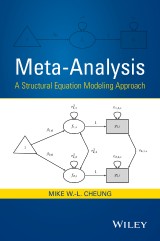Details

Meta-Analysis
A Structural Equation Modeling Approach1. Aufl.
|
CHF 51.00 |
|
| Verlag: | Wiley |
| Format: | EPUB |
| Veröffentl.: | 07.04.2015 |
| ISBN/EAN: | 9781118957820 |
| Sprache: | englisch |
| Anzahl Seiten: | 400 |
DRM-geschütztes eBook, Sie benötigen z.B. Adobe Digital Editions und eine Adobe ID zum Lesen.
Beschreibungen
<p><b>Presents a novel approach to conducting meta-analysis using structural equation modeling.</b></p> <p>Structural equation modeling (SEM) and meta-analysis are two powerful statistical methods in the educational, social, behavioral, and medical sciences. They are often treated as two unrelated topics in the literature. This book presents a unified framework on analyzing meta-analytic data within the SEM framework, and illustrates how to conduct meta-analysis using the metaSEM package in the R statistical environment.</p> <p><i>Meta-Analysis: A Structural Equation Modeling Approach</i> begins by introducing the importance of SEM and meta-analysis in answering research questions. Key ideas in meta-analysis and SEM are briefly reviewed, and various meta-analytic models are then introduced and linked to the SEM framework. Fixed-, random-, and mixed-effects models in univariate and multivariate meta-analyses, three-level meta-analysis, and meta-analytic structural equation modeling, are introduced. Advanced topics, such as using restricted maximum likelihood estimation method and handling missing covariates, are also covered. Readers will learn a single framework to apply both meta-analysis and SEM. Examples in R and in Mplus are included. </p> <p>This book will be a valuable resource for statistical and academic researchers and graduate students carrying out meta-analyses, and will also be useful to researchers and statisticians using SEM in biostatistics. Basic knowledge of either SEM or meta-analysis will be helpful in understanding the materials in this book.</p>
<p>Preface xiii</p> <p>Acknowledgments xv</p> <p>List of abbreviations xvii</p> <p>List of figures xix</p> <p>List of tables xxi</p> <p><b>1 Introduction 1</b></p> <p>1.1 What is meta-analysis? 1</p> <p>1.2 What is structural equation modeling? 2</p> <p>1.3 Reasons for writing a book on meta-analysis and structural equation modeling 3</p> <p>1.4 Outline of the following chapters 6</p> <p>1.5 Concluding remarks and further readings 8</p> <p><b>2 Brief review of structural equation modeling 13</b></p> <p>2.1 Introduction 13</p> <p>2.2 Model specification 14</p> <p>2.3 Common structural equation models 18</p> <p>2.4 Estimation methods, test statistics, and goodness-of-fit indices 25</p> <p>2.5 Extensions on structural equation modeling 38</p> <p>2.6 Concluding remarks and further readings 42</p> <p><b>3 Computing effect sizes for meta-analysis 48</b></p> <p>3.1 Introduction 48</p> <p>3.2 Effect sizes for univariate meta-analysis 50</p> <p>3.3 Effect sizes for multivariate meta-analysis 57</p> <p>3.4 General approach to estimating the sampling variances and covariances 60</p> <p>3.5 Illustrations Using R 68</p> <p>3.6 Concluding remarks and further readings 78</p> <p><b>4 Univariate meta-analysis 81</b></p> <p>4.1 Introduction 81</p> <p>4.2 Fixed-effects model 83</p> <p>4.3 Random-effects model 87</p> <p>4.4 Comparisons between the fixed- and the random-effects models 93</p> <p>4.5 Mixed-effects model 96</p> <p>4.6 Structural equation modeling approach 100</p> <p>4.7 Illustrations using R 105</p> <p>4.8 Concluding remarks and further readings 116</p> <p><b>5 Multivariate meta-analysis 121</b></p> <p>5.1 Introduction 121</p> <p>5.2 Fixed-effects model 124</p> <p>5.3 Random-effects model 127</p> <p>5.4 Mixed-effects model 134</p> <p>5.5 Structural equation modeling approach 136</p> <p>5.6 Extensions: mediation and moderation models on the effect sizes 140</p> <p>5.7 Illustrations using R 145</p> <p>5.8 Concluding remarks and further readings 174</p> <p><b>6 Three-level meta-analysis 179</b></p> <p>6.1 Introduction 179</p> <p>6.2 Three-level model 183</p> <p>6.3 Structural equation modeling approach 188</p> <p>6.4 Relationship between the multivariate and the three-level meta-analyses 195</p> <p>6.5 Illustrations using R 200</p> <p>6.6 Concluding remarks and further readings 210</p> <p><b>7 Meta-analytic structural equation modeling 214</b></p> <p>7.1 Introduction 214</p> <p>7.2 Conventional approaches 218</p> <p>7.3 Two-stage structural equation modeling: fixed-effects models 223</p> <p>7.4 Two-stage structural equation modeling: random-effects models 233</p> <p>7.5 Related issues 235</p> <p>7.6 Illustrations using R 244</p> <p>7.7 Concluding remarks and further readings 273</p> <p><b>8 Advanced topics in SEM-based meta-analysis 279</b></p> <p>8.1 Restricted (or residual) maximum likelihood estimation 279</p> <p>8.2 Missing values in the moderators 289</p> <p>8.3 Illustrations using R 294</p> <p>8.4 Concluding remarks and further readings 309</p> <p><b>9 Conducting meta-analysis with Mplus 313</b></p> <p>9.1 Introduction 313</p> <p>9.2 Univariate meta-analysis 314</p> <p>9.3 Multivariate meta-analysis 327</p> <p>9.4 Three-level meta-analysis 346</p> <p>9.5 Concluding remarks and further readings 353</p> <p><b>A A brief introduction to R, OpenMx, and metaSEM packages 356</b></p> <p>A.1 R 357</p> <p>A.2 OpenMx 362</p> <p>A.3 metaSEM 364</p> <p>References 368</p> <p>Index 369</p>
<p>"This book will be a valuable resource for statistical and academic researchers and graduate students carrying out meta-analyses, and will also be useful to researchers and statisticians using SEM in biostatistics. cover, would sit well on the bookshelves of those interested in this increasingly important field of scientific endeavour." (<i>Zentralblatt MATH</i>, 1 June 2015)</p>
<b>Mike W.-L. Cheung</b>, <i>National University of Singapore, Singapore</i>
<p><b>Presents a novel approach to conducting meta-analysis using structural equation modeling.</b></p> <p>Structural equation modeling (SEM) and meta-analysis are two powerful statistical methods in the educational, social, behavioral, and medical sciences. They are often treated as two unrelated topics in the literature. This book presents a unified framework on analyzing meta-analytic data within the SEM framework, and illustrates how to conduct meta-analysis using the metaSEM package in the R statistical environment.</p> <p><i>Meta-Analysis: A Structural Equation Modeling Approach</i> begins by introducing the importance of SEM and meta-analysis in answering research questions. Key ideas in meta-analysis and SEM are briefly reviewed, and various meta-analytic models are then introduced and linked to the SEM framework. Fixed-, random-, and mixed-effects models in univariate and multivariate meta-analyses, three-level meta-analysis, and meta-analytic structural equation modeling, are introduced. Advanced topics, such as using restricted maximum likelihood estimation method and handling missing covariates, are also covered. Readers will learn a single framework to apply both meta-analysis and SEM. Examples in R and some of the analyses in Mplus and LISREL are included.</p> <p>This book will be a valuable resource for statistical and academic researchers and graduate students carrying out meta-analyses, and will also be useful to researchers and statisticians using SEM in biostatistics. Basic knowledge of either SEM or meta-analysis will be helpful in understanding the materials in this book.</p>

















